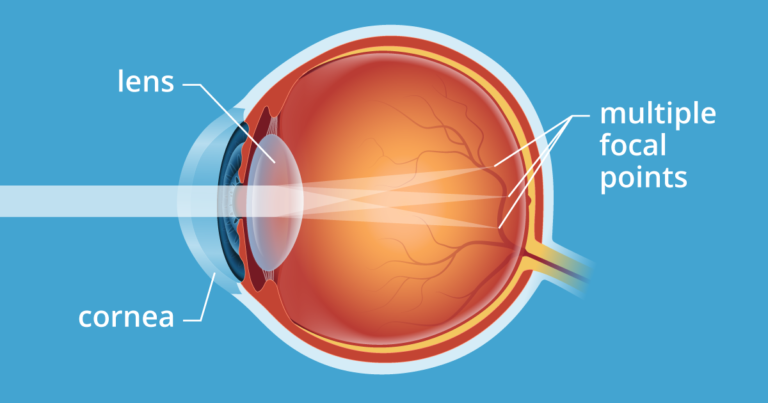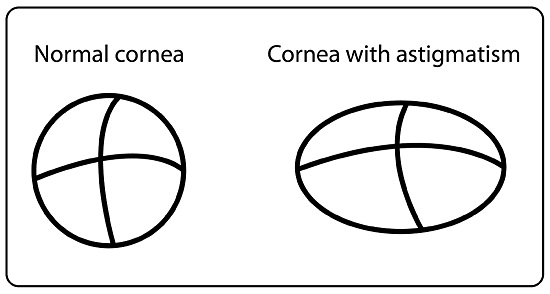
The word astigmatism can be confusing to a lot of people. The word “astigmatism” is from the Greek roots a- (“without”) and stigma (“point”). When light rays enter the eye, astigmatism creates two or more separate images in different points.
What causes Astigmatism?
The clear front surface of the eye (the cornea) is normally round like a baseball. Most astigmatism is caused by unequal curvature of the cornea resulting in a football shaped front surface. In other words, the cornea is more curved in one meridian – which is usually 90 degrees apart – than the least curved meridian. This can result in headaches and blurred vision because light is not focused in one point to allow the eye to see clearly. No one knows for sure why people develop astigmatism, but it is very common. About one third of Americans 20 and older have clinically significant astigmatism in at least one eye.

Symptoms of Astigmatism
Astigmatism causes objects at all distances to be blurry or distorted. This can result in eye strain, headaches, and in children can lead to learning problems in the classroom.
How to correct Astigmatism
Astigmatism is corrected using eyeglass lenses, specialty contact lenses called toric contact lenses, or LASIK. To determine the amount of astigmatism that you have, your doctor will perform a series of tests:
Auto-Keratometry/Topography: An auto-keratometer is an instrument used to measure the curvature on the front surface of the eye. You might have experienced this technology when asked to look at the hot air balloon at a distance as it goes in and out of focus. A topographer creates a curvature map on the front surface of the eye and provides even more detail on the shape of the cornea. This technology is routinely used for contact lens fittings.
Refraction: Using an instrument called a phoropter, a series of lenses are placed in front of your eyes to see how they focus light. You will look at a chart at the end of a room through the phoropter. The doctor will ask you, “Which of the two lenses makes the line the clearest, 1 or 2?” Despite improved technology, patient response remains integral in generating an accurate eyeglass prescription.
With the information from these tests, your optometrist will be able to determine the proper amount of astigmatism to prescribe in your glasses and/or contact lenses for clear and comfortable vision.
Astigmatism also occurs in a relatively rare condition called keratoconus which causes the cornea to be thin and cone-shaped. This results in large amounts of astigmatism resulting in poor vision which cannot be corrected with glasses. In this case, rigid or hard contact lenses are the only option to provide clearer vision. Topography is essential for diagnosing keratoconus early, fortunately, we perform this test routinely for our patients.
Call our office today (925) 744-7900 to schedule an eye examination if you have headaches, eye strain, distorted vision. You may have uncorrected astigmatism. We look forward to going over all the options to help you see clearly and comfortably!




